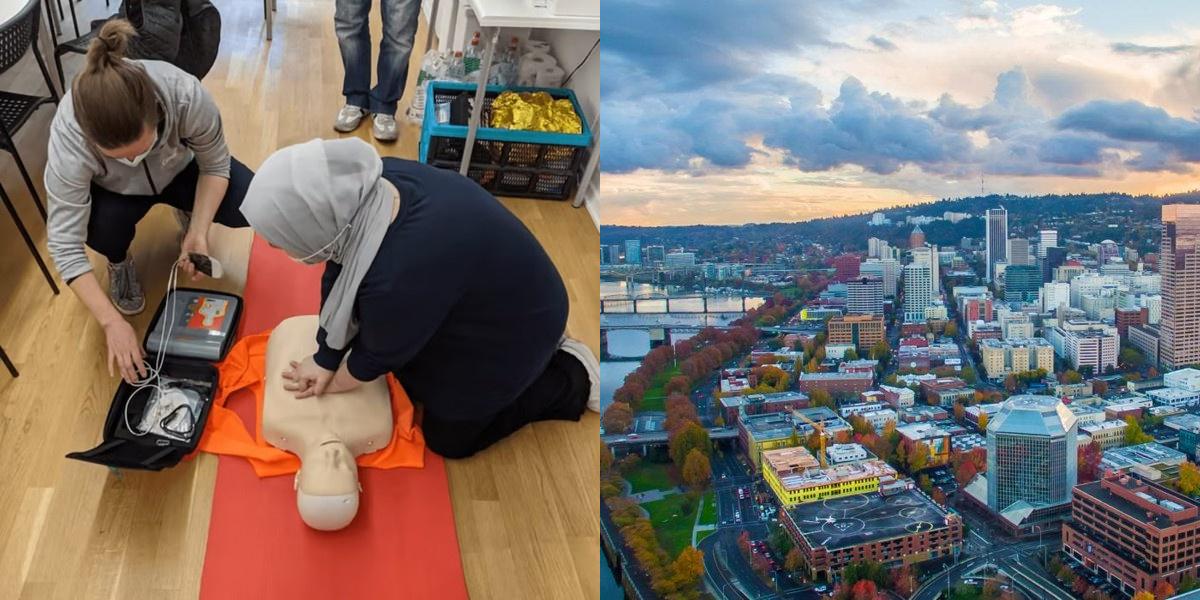What is a Paramedic?
A paramedic is a highly trained medical professional who provides emergency medical care to individuals who are injured or experiencing a medical emergency. They work as part of a team and are often the first responders on the scene. Some of their responsibilities include assessing patients, administering medication, performing medical procedures, and transporting patients to the hospital.
Where does a Paramedic work?
Paramedics work in a variety of settings, including ambulances, fire departments, hospitals, and other healthcare facilities. They may also be employed by private companies that provide medical transportation services.
How to Become a Paramedic in Oregon?
To become a Paramedic in Oregon, you must complete an accredited Paramedic training program, typically an associate's degree lasting 1-2 years. After completing the program, you must pass the National Registry of Emergency Medical Technicians (NREMT) exam. Once you pass the NREMT exam, you can apply for Paramedic certification in Oregon. With your certification, you'll be ready to explore employment opportunities in the emergency medical services field, where you can make a significant impact by providing critical care in emergencies. This comprehensive pathway ensures you are well-prepared and qualified to serve as a Paramedic in Oregon.
What are the requirements to become a Paramedic in Oregon?
To become a paramedic in Oregon, you must meet certain educational and legal requirements. First, you must be at least 18 years old and have a high school diploma or GED. You will also need to complete a state-approved paramedic training program, which typically takes about two years to complete. This program includes both classroom instruction and hands-on clinical experience.
After completing the training program, you must pass the National Registry of Emergency Medical Technicians (NREMT) exam to become certified as a paramedic. Once certified, you can apply for a state license from the Oregon Health Authority's Emergency Medical Services and Trauma Systems Program.
How do I get my Paramedic certification?
If you have a passion for helping others and thrive in high-pressure situations, a career as a paramedic may be perfect for you. Paramedics play a crucial role in the healthcare system, providing emergency medical care to those in need. To become a paramedic, you will need to complete a certification program that includes both classroom instruction and hands-on training.
Here are the steps you need to take to get your paramedic certification:
1. Research certification requirements: Start by researching the specific requirements for paramedic certification in your area. Different states and countries may have different requirements, so it's important to understand what is required in your jurisdiction.
2. Complete a high school diploma or GED: Before you can enroll in a paramedic certification program, you will need to have a high school diploma or a GED. If you haven't completed high school, you will need to obtain your GED before proceeding.
3. Enroll in a paramedic certification program: Once you have met the educational requirements, you can enroll in a paramedic certification program. These programs are typically offered at community colleges, technical schools, or through hospitals and emergency medical services (EMS) agencies. The program will consist of both classroom instruction and hands-on training, covering topics such as anatomy, physiology, pharmacology, and emergency medical procedures.
4. Complete the required coursework: During your paramedic certification program, you will need to complete a series of courses that cover the knowledge and skills necessary to become a competent paramedic. This will include both theoretical and practical components, allowing you to apply what you have learned in real-life situations.
5. Complete clinical rotations: In addition to the classroom instruction, you will also need to complete a certain number of clinical rotations. These rotations will allow you to gain practical experience in a variety of healthcare settings, such as hospitals, ambulances, and emergency rooms. You will work under the supervision of experienced paramedics, learning how to assess patients, administer medications, and provide emergency care.
6. Pass the National Registry of Emergency Medical Technicians (NREMT) exam: Once you have completed your paramedic certification program, you will need to pass the NREMT exam to become a certified paramedic. This exam tests your knowledge and skills in a variety of areas, including patient assessment, trauma management, and medical procedures. Passing this exam is a requirement for most paramedic jobs in the United States.
7. Apply for state licensure: After passing the NREMT exam, you will need to apply for state licensure in order to practice as a paramedic. The specific requirements for licensure will vary by state but typically involve submitting an application, paying a fee, and providing proof of your education and certification.
8. Continue your education: Once you have obtained your paramedic certification and licensure, it's important to continue your education to stay current in the field. Many paramedics pursue additional certifications or advanced degrees to expand their knowledge and opportunities for career advancement.
How do I get a job as a Paramedic?
Once you have obtained your paramedic certification and licensure, you will be ready to start your career as a paramedic. Here are some steps you can take to increase your chances of getting a job in this field:
1. Gain experience: While completing your paramedic certification program, take advantage of any opportunities to gain practical experience. This could include participating in internships, volunteering with local EMS agencies, or working as an emergency medical technician (EMT) while pursuing your certification. Having hands-on experience will make you a more competitive candidate when applying for paramedic positions.
2. Network: Networking is an important part of any job search, and the field of paramedics is no exception. Attend job fairs, join professional organizations, and connect with other paramedics in your area. Building relationships in the industry can lead to job opportunities and valuable connections.
3. Prepare a strong resume and cover letter: When applying for paramedic positions, it's important to have a well-written resume and cover letter that highlight your skills, experience, and qualifications. Tailor your resume to each job you apply for, emphasizing relevant experience and certifications.
4. Prepare for interviews: Before attending job interviews, take the time to research the organization you are applying to and prepare answers to common interview questions. Practice your responses with a friend or family member to build confidence and ensure you are presenting yourself in the best possible light.
5. Consider additional certifications: In addition to your paramedic certification, obtaining additional certifications can make you a more competitive candidate. For example, certifications in advanced cardiac life support (ACLS) or pediatric advanced life support (PALS) can demonstrate your expertise in specific areas of emergency medicine.
6. Stay current in the field: The field of emergency medicine is constantly evolving, so it's important to stay current with the latest advancements and best practices. Attend conferences, take continuing education courses, and read industry publications to stay informed and demonstrate your commitment to ongoing professional development.
7. Apply for positions: Once you feel prepared, start applying for paramedic positions. Check job boards, reach out to local EMS agencies, and consider submitting your resume and cover letter directly to organizations you are interested in working for. Be persistent and follow up on applications to show your enthusiasm and dedication.
Remember that landing your first job as a paramedic may take time and persistence. Don't get discouraged if you don't receive an offer right away – keep applying and refining your job search strategies until you find the right opportunity.
Career Paths and Opportunities after Becoming a Paramedic
Becoming a paramedic opens up a wide range of career paths and opportunities within the field of emergency medicine. While many paramedics work on ambulances, there are several other career options to consider. Here are some potential career paths and opportunities for paramedics:
-
Emergency Medical Services (EMS) Supervisor: As a paramedic with several years of experience, you may have the opportunity to advance into a supervisory or management role within an EMS agency. In this position, you would be responsible for overseeing the daily operations of the agency, managing staff, and ensuring that high-quality care is provided to patients.
-
Flight Paramedic: If you enjoy working in high-pressure situations and have a passion for aviation, becoming a flight paramedic may be a good fit for you. Flight paramedics are specially trained to provide emergency medical care in helicopter or airplane settings. This role often involves responding to critical incidents and transporting patients to specialized care facilities.
-
Critical Care Transport Paramedic: Critical care transport paramedics work on specialized transport teams that transfer critically ill or injured patients between healthcare facilities. This role requires advanced training and knowledge in areas such as ventilator management, advanced cardiac life support, and invasive procedures.
-
Emergency Room Technician: Some paramedics choose to transition into roles within hospital emergency rooms. As an emergency room technician, you would provide direct patient care under the supervision of nurses and physicians. This role allows you to work in a fast-paced environment and gain exposure to a wide range of medical conditions.
-
Paramedic Instructor: If you have a passion for teaching and mentoring others, becoming a paramedic instructor may be a good career option. In this role, you would be responsible for teaching and evaluating students in paramedic certification programs. You would also stay up-to-date with the latest advancements in emergency medicine and contribute to the development of curriculum.
-
Specialized Paramedic Roles: There are also several specialized paramedic roles that you may choose to pursue, depending on your interests and career goals. These roles can include working as a tactical paramedic, dive medic, or search and rescue paramedic. These positions often require additional training and certifications, but can provide unique and rewarding experiences.
Keep in mind that the specific career paths available to you may vary depending on your location and the opportunities in your area. It's important to continuously seek out new opportunities for professional growth and development, whether that be through additional certifications, advanced degrees, or networking within the industry.
Frequently Asked Questions






